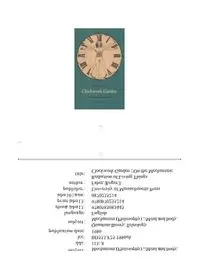
Clockwork garden: on the mechanistic reduction of living things PDF
Preview Clockwork garden: on the mechanistic reduction of living things
Clockwork Garden : On the Mechanistic title: Reduction of Living Things author: Faber, Roger J. publisher: University of Massachusetts Press isbn10 | asin: 0870235214 print isbn13: 9780870235214 ebook isbn13: 9780585083445 language: English Mechanism (Philosophy) , Mind and body, subject Quantum theory, Teleology. publication date: 1986 lcc: BD553.F25 1986eb ddc: 113/.8 Mechanism (Philosophy) , Mind and body, subject: Quantum theory, Teleology. Page iii Clockwork Garden On the Mechanistic Reduction of Living Things Roger J. Faber THE UNIVERSITY OF MASSACHUSETTS PRESS AMHERST, 1986 Page iv Copyright © 1986 by The University of Massachusetts Press All rights reserved Printed in the United States of America Set in Linotron Sabon by G & S Typesetters Printed by Cushing-Malloy and bound by John Dekker & Sons Library of Congress Cataloging-in-Publication Data Faber, Roger J., 1931 Clockwork garden. Bibliography: p. Includes index. 1. Mechanism (Philosophy) 2. Mind and body. 3. Quantum theory. 4. Teleology. 1. Title. BD553.F25 1986 113'.8 8528408 ISBN 0870235214 (alk. paper) Page v To my father Page vii Contents Preface ix 1 3 Wholes and Parts: Introductory Survey 2 12 The Case for Mechanism 3 33 Reduction and Common Sense 4 55 Teleology: Reducing Cybernetics 5 76 Teleology: Goals and Adaptations 6 99 Teleology: Selectionism 7 122 Nonreductive Physicalism 8 139 Mental Events in Prequantal Atomism 9 157 Potentiality in the Quantum Theory 10 184 Mental Events in an Indefinite World 11 227 Notes for a Quantal World Picture Bibliography 257 Index 263 Page ix Preface In this book I try to discern the human significance of our current scientific world picture, evaluating competing interpretations and arguing finally for one of them. Now arguments do not spring spontaneously out of the air; we develop them in order to organize our intuitions, the informal distillation of our experiences of the world. Nor do arguments complete the effort to understand; they serve only insofar as they help to make sense of further experiences, clarifying and perhaps correcting our intuitions. Experiences are both the source and the end of reasoning; we cannot rest until we have brought intuition and argumentation into harmony. It seems appropriate, therefore, to introduce this volume on the mechanist philosophy of nature by recounting one of the sources of my own intuitions. Looking for a colleague, a herpetologist, I once wandered into an unoccupied research laboratory, where what seemed to be the postmortem dissection of a turtle stood in a state of temporary suspension. The body, minus the lower shell, was pinned on its back to a wooden slab, its internal organs exposed. I soon saw, however, that this was no corpse; the creature's legs were slowly tracing a crawling motion in the air. The image of that disturbing sight stayed with me. To cool my indignation, I told myself that Page x the body I had seen was only a mechanism made of cells; that nothing was occurring on the dissecting board that differed significantly from what goes on in an automobile repair shop. The turtle with beating heart and waving limbs was in all respectsexcept for the stuff from which it was madelike a Volkswagen on a repair rack with its engine idling and wheels spinning. Was it trying to escape? No, not in the full sense of "trying." Not more so than a heat-seeking missile, say, could try to hit a target. Was it feeling pain? No; like any mechanism it could not feel, it could only function. The firing of its pain-sensing neurons was like the glowing of a lamp that warns about oil pressure or overheating in an automobile. I learned later that the dissection had begun with the routine precaution of severing the animal's spinal cord just below the head, so the possibility of pain did not arise. The warning lamp had been disconnected. Still, a wider question remained: It is the common thread running through this volume. Does a living organism differ from a functioning machine only in being made of carbohydrates rather than high-carbon steel and in having been formed by the spontaneous self-assembly of molecules rather than by design in a factory? Having some personal experience of what it is like to be a living organism, I felt inclined to answer no. To give that answer is to make an antireductive conjecture about the organic world. Finding support for the conjecture is a daunting task, not least because the mechanistic view of living things is firmly rooted in modern evolutionary biology. Nevertheless, the attempt to counter, or at least to temper, mechanistic reductionism appeals to humanists of all ideological stripes. Some Christians have objected to evolutionism because it conflicts with a literal interpretation of the Book of Genesis; some Marxists have objected to the elevation of parts over wholes because it degrades the collective in favor of the individual. But I submit that threats to these special orthodoxies pale to insignificance compared with the insult that reductionism offers to ordinary, nondenominational humanism. That threat, the demeaning of the human person, touches religious and nonreligious alike. Having exposed a little of the origin of this study, let me also alert the reader to the character of its destination. This book is offered in support of the antimechanist conjecture. Chapters 1 through 7 explore what can be done without raising the ancient
